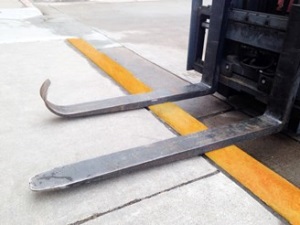Complete Powerpoint slide presentation for forklift instructors. Ready made training course
when to replace forklift forks
 This article is by Netforks from the USA. I have anglised it from the point of view of legislation etc.
This article is by Netforks from the USA. I have anglised it from the point of view of legislation etc.
The forklift fork is often overlooked and under-inspected. Many are unaware of how often one should inspect their forks, and how to inspect them. Forks should be inspected on a per-operation basis. As part of a pre-operation inspection, forklift forks should ideally be inspected for signs of cracks, bends, excessive wear or damage to either the fork tine or the positioning lock if applicable. In addition, forks come under the UK LOLER legislation as far as inspection is concerned. Checks should be as follows:
-
Excessive wear to the forks – Forklift forks decrease in thickness over time due to normal wear. However, any wear to the fork more than 10 percent of the total thickness is considered excessive. Forks that show this amount of wear should be replaced.
-
Fractures due to stress or collision – Be sure to inspect the forks closely for fractures and gouges. The fork heel and parts of the fork closest to the machine typically receive the most wear. Even small cracks and gouges are signs forks need to be replaced.
-
Damage to the fork tip – Since fork tips are usually the first part of the fork to come in contact with material, excessive wear or damage to the tips is a clear indicator the forks should be replaced.
-
Any bends or uneven surfaces on the fork – All forks are delivered with a 90-degree angle from the shank to the blade. If any bend or uneven surface is detected on either the blade or shank, the fork(s) need replacing.
-
Difference in fork blade height – A difference in the height of each fork blade should stay within 3 percent of the fork length. Therefore if the forks in question are 42 inches long the allowable difference in fork height would be 1.26 inches. Any difference in fork height beyond 1.26 inches is a sign that both forks need to be replaced.
-
Wear or damage to the fork hook – Noticeable wear, crushing, pulling and other deformities are signs that the fork hooks need to be replaced. Furthermore, if the wear to the hook is causing an excessive amount of distance between the fork and the carriage, the hook(s) should be replaced.
-
Wear or damage to positioning lock – If a positioning lock is no longer capable of locking completely due to wear, the forks should immediately be removed from duty until the part is replaced. Operating without a fully functional positioning lock is a safety hazard and illegal.
Here are some common questions regarding fork replacement
-
Can a single fork be replaced or should they be replaced in pairs?
While only a single fork might show signs of excessive wear or damage, it is not safe to replace only one fork. It is highly recommended forks be replaced only in pairs to ensure equal performance. Having two different forks with unique amounts of wear and disproportionate hourly usage provides a number of safety concerns. -
Is it ok to make custom repairs or modification to the forks?
It is typically recommended that only the fork manufacturer make repairs or modifications to ensure forks meet safety standards. Always contact your fork provider first when in need of modification. -
How do I determine replacement fork quality?
Forks made from high quality boron-carbon alloy high strength steel are rated 20 percent stronger than those made with 40CR. In addition, forks that are fully immersed into industrial heat treatment ovens and cooling pools are the most durable. Premium quality forklift forks should meet or exceed all ANSI/ITSDF and ISO standards.
Disclaimer. The legislative information contained on this web site is my interpretation of the law based on many years in the health and safety business. A definitive interpretation can only be given by the courts. I will therefore not be held responsible for any accident/incident/prosecution arising as a consequence of anyone using any information obtained from this web site.